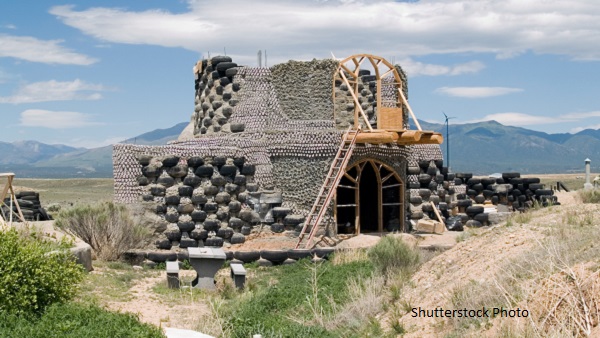
Mass Appeal: Building Steel-Belted Houses
by Tim Knipe
“What other species on the planet could be in this predicament?” asks Michael Reynolds. “The mud wasps can all make mud nests, beavers can all cut wood. People...most of them...are helpless when it comes to building their own homes. Housing has been taken away from people.”
For the past forty years, architect Michael Reynolds has been developing a building system which will, in effect, free people from the tyranny of costly mortgages, energy bills and even part of their grocery bills. His houses are called Earthships and they are built primarily from recycled materials – used tires and aluminum cans – and finished with adobe mud. Heating and cooling is based on a principle called “mass.” Power is gleaned from the sun or wind. Earthships can be constructed by unskilled builders and inhabited free from any dependence on the power grid.
Reynolds, who runs a company called Solar Survival Architecture in Taos, New Mexico, personally tested each experimental structure along the way. The result is a house design that satisfies his rigorous criteria. He calls them Earthships because they are vessels rooted in the Earth, and they will carry people through whatever the future brings, be it climate change, economic adversity, famine, or peace and prosperity.
Reynolds' quest for sustainable housing began with baling tin cans with wire into small blocks. The design was patented but never utilized because it was too labor-intensive. Instead, he began laying cans directly into cement mortar. At first, the cans-in-mortar construction was used to fill in between posts in more traditional post-and-beam structures. This evolved into using cans alone in dome-style construction.
When the energy crunch hit in the mid-70s, Reynolds began to explore the concept of mass. This led him to design structures in which the walls themselves, because of their extremely concentrated mass, retain temperature.
In developing the Earthship design, Reynolds kept his eye on two key factors: cost and sustainability. To be truly sustainable for the long term, he felt that the structures must “join with the Earth, not resist it.” Thus, in addition to the mass of the structure's walls, the natural elements of the Earth itself are included. Earthships are partially submerged into the ground, with the excavated soil piled nearly to the roof on the northern faces.
All of the walls, except for the incidental ones enclosing closets and bathrooms and the glass wall, have as their main component steel-belted radial tires filled with dirt.
The tires are set in staggered courses similar to bricks. Each tire is put into place empty, then filled with dirt from the excavation. The loose dirt is pounded into the tire rim and more dirt successively added until the tire is rock-solid and all but immovable.
The unusual thickness of the walls allows for a wide distribution of loads, thereby reducing the weight that actually reaches the ground. This attribute qualifies them as structural bearing walls and their width eliminates the need for additional footings or foundations.
Using the Earthship concept as a building block, Reynolds has gone on to a larger scale: an Earthship community. Rural Earthship Alternative Community Habitat (REACH) is currently being initiated on a mountainside near Taos, New Mexico. The basic deed restriction is that only Earthships may be built in this totally self-sustaining community.
“What we're trying to do with these Earthships,” says Reynolds, “is make a way for human life to live as intelligently as plant and animal life.”
Learn More
Solar Survival
Earthship: How to Build Your Own, Vol. 1 by Michael Reynolds (Solar Survival Architecture, 1990)
Earthship: Systems and Components, Vol. 2 by Michael Reynolds (Earthship Biotecture, 1991)
This article was published in Natural Life Magazine in 1995.
|

